Medieval Artillery by Ian Heath
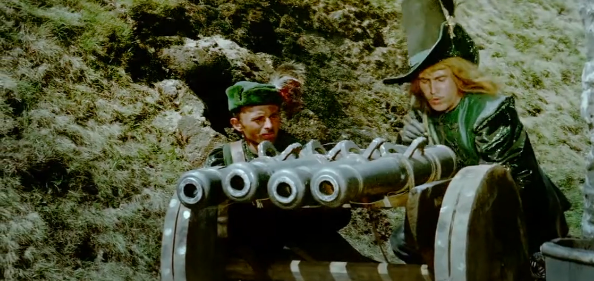
Four-barreled cannon from the Polish-Soviet film "Pan Volodyevsky" (1969)
and fell to the ground; and a third of the trees burned down,
and all the green grass was burned up.”
Apocalypse, or Revelation of John the Theologian, 9:17
Documents stories. “Isn’t it time to talk about the “multiple-charged” guns of the “transitional period”?” - our reader Vladimir wrote in a comment to one of the previous materials and ... "Why not write"? And at the same time, why not acquaint VO readers with what our foreign historian colleagues write on the topic of medieval artillery, as well as artillery of the transitional period, and in particular the well-known British historian in the field of military history Ian Heath. As they say, information of a comparative nature is best, because one wrote one thing, the other wrote another, and everyone uses different sources. So…
“The earliest mention of a gun used in the field and not in a siege (both defenders and attackers) is from 1339, when a new type of light artillery called the ribodekin or ribo was recorded in the ledgers of Bruges. Froissart describes it as "3 or 4 guns tied together", and we know from other sources that it took the form of a series of small guns mounted on a two- or four-wheeled cart (which Froissart likens to a medieval cart), with a fixed shield to protect the shooters . They called such a device char de guerre or "military wagon". The barrels were connected in such a way that it was possible to shoot either all at the same time, or in quick succession, one by one from each.
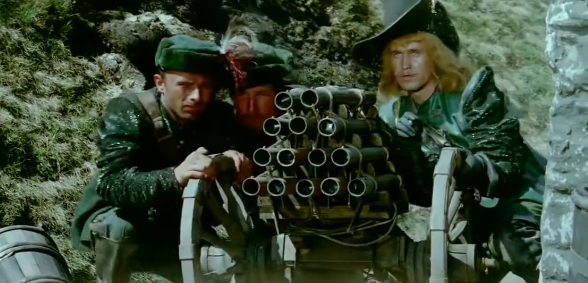
14-barrel ribodekin from the movie "Pan Volodyevsky" (1969)
Three absolutely monstrous Italian inventions of 1387 are known, each of them had up to 144 individual barrels in three tiers, grouped in 48 barrels, from which they could be fired in groups of 12 barrels. Ribodeken was probably originally designed to protect the bottlenecks in castles, such as gates, passages and breaches. But then its potential as a source of mobile firepower in the field was soon also recognized, and within a short time ribodekin began to be used in large numbers in field battles, especially in the Netherlands.
In 1382, the rebels of Gontois before Bruges had up to 200 of these char de guerre, which are described as high-wheeled wagons with long protruding iron spikes for protection. They appear to have been used in large numbers under Roosebeck, and in 1411 the Duke of Burgundy's army blockading Paris is said to have had 2 of these wagons, which is either an exaggeration or is not so much a reference to the number of installations as to the number of stems in them.
However, the ribodeken began to fall out of favor shortly thereafter, no doubt due to the widespread use of the pistol. Nevertheless, the word "organ gun", used instead of ribodeken from the end of the XNUMXth century onwards, testifies to the continued survival of such weapons. There are images of guns of the late XNUMXth century captured during the Burgundian wars, and among them there are several wheeled carriages carrying several small barrels. By the way, most often there were three such trunks.
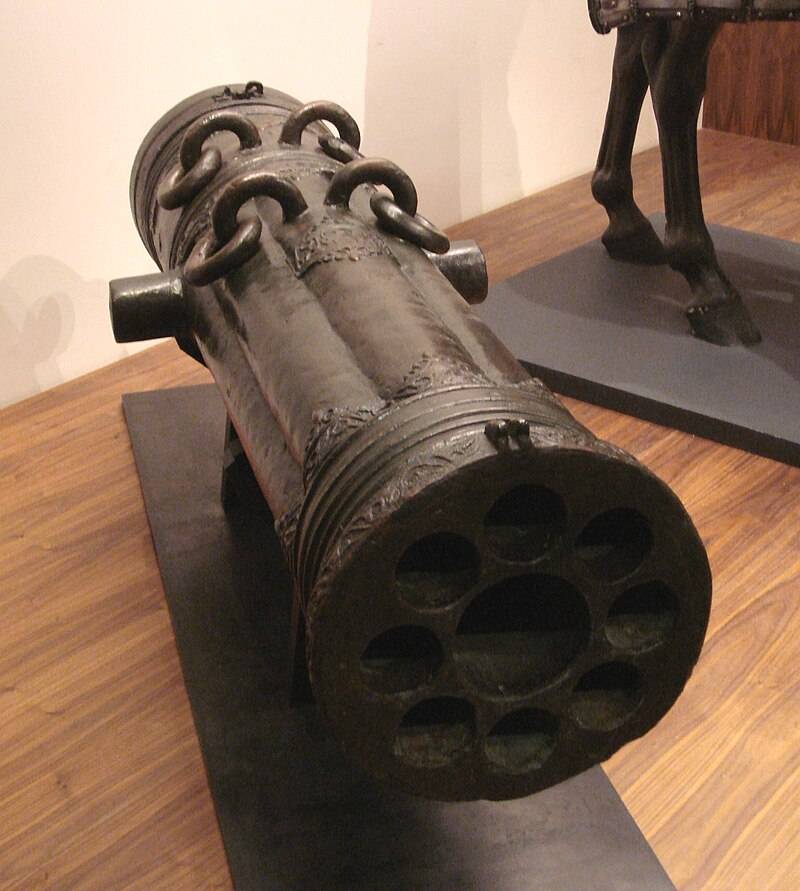
Multi-barreled Turkish cannon of the early XNUMXth century. Army Museum in Paris. Photo of the author
Such multi-barreled varieties of light artillery should not be confused with cannons, which also sometimes had two or three barrels. The main difference here is that such guns were loaded from the treasury and had a wedge lock. But the ribodekins were charged from the muzzle, like an arquebus. However, the leakage of propellant gas through leaky connections made this method of loading dangerous, and soon most even large-caliber guns were also loaded from the muzzle.
There were even light guns made of wood with a metal barrel inside. Petrarch, for example, wrote that such a wooden cannon was made in 1343. Then forged tools with barrels reinforced with hoops became widespread. True, as one chronicler tells us, such tools did not last long and required replacement every 3-4 days.
The earliest references to wheeled carriages date back to the 1376th century and, again, in relation to the ribodekins mentioned above. Heavier guns on wheeled carriages appeared only a little later. For example, an Italian source refers to the two-wheeled carriages used during the siege of Kero in 1420. However, they remained extremely rare until the 1430th century, when they were further developed during the Hussite wars of the XNUMXs and XNUMXs, but they were hardly numerous in Western Europe until the middle of the XNUMXth century.
The next stage in their development was the lifting carriage, which was the means of lowering or raising the barrel used until the widespread introduction of trunnions (first introduced around 1400) in the second half of the XNUMXth century. It is commonly referred to today as the "Burgundian" gun carriage due to its frequent occurrence among the many artillery pieces captured by the Swiss during the Burgundian Wars and which can still be seen in Swiss museums.
Be that as it may, by the beginning of the 10th century, there were enough cannons to make their division into different categories obvious. Bombards at that time were the largest guns of all. They sometimes weighed over 000 pounds and could fire shots weighing many hundreds of pounds. Bordeaux in 1420, for example, had a large bombard capable of firing a 7 quintal (784 lb) stone cannonball, and made another that could fire 5–5,25 quintal cannonballs.
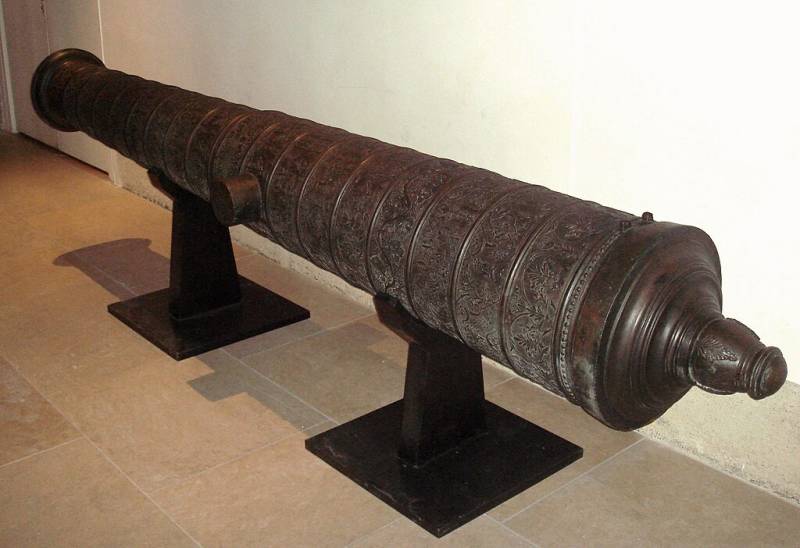
Ottoman cast bronze cannon from the late 385th century. Length 178 cm, caliber 2 mm, weight 910 kg. Captured in Algiers in 1830. Army Museum in Paris. Photo of the author
The second largest type of weapon was the fowler or weigler, which first appeared in the Netherlands at the very beginning of the 8th century. It could reach 300 feet in length and range in weight from 4 pounds to several thousand, but was generally at the bottom of that scale. It was usually breech loaded and could sometimes be found mounted alongside ribodekins. The cannons, called krappods or krapudins, were somewhat smaller, only 8–XNUMX feet long, while the culverine and serpentine were the smallest types of guns, although they usually had rather long barrels compared to their caliber. Hence their "serpentine" names. So, kulevrina comes from "colubra", which means a snake.
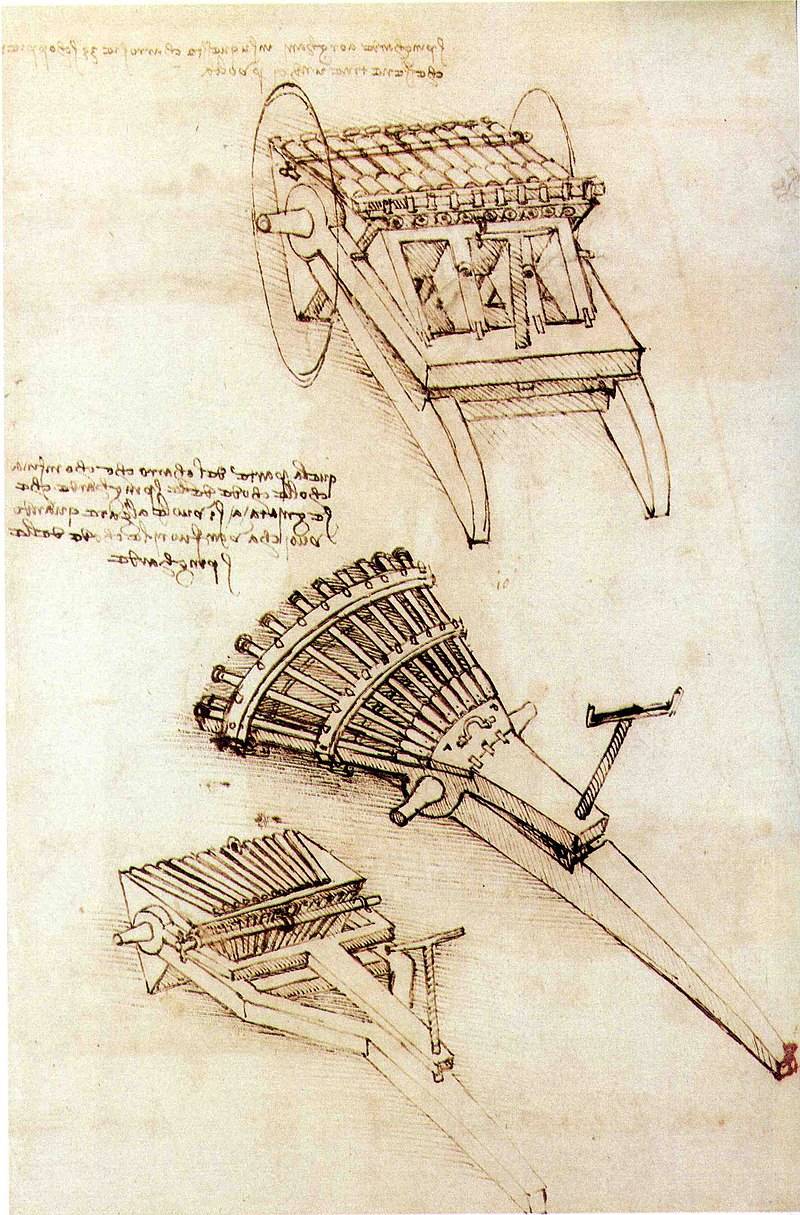
Variants of rapid-fire guns (drawing by Leonardo da Vinci)
Charles the Bold, for example, had one 30-foot culverin and six more culverins 8–11 feet long at the siege of Neisse in 1474. To distinguish them from manual culverins, they were called "large culverins". According to the Sieur de Saint-Remy, an eyewitness, the French had serpentines at Agincourt in 1415.
Mortars also appeared at the end of the XNUMXth century, at first short and heavy in large caliber, but in the XNUMXth century their caliber decreased.
The earliest cannons fired either small iron balls or heavy arrows, as depicted in the famous Milemet miniature. They usually had oak shafts, iron tips, and iron, steel, or brass blades, and could weigh 15–30 pounds, sometimes more. Froissart, for example, makes several references to heavy arrows, allegedly weighing 200 pounds, which were used at the siege of Ardra in 1377. Arrows were the most common type of artillery projectile until the early 1340s.
The lead bullets used in the smallest guns and the iron cannonballs mentioned in the Florentine report of 1326 and used at Crécy in 1346 were later replaced by stone ones as the caliber of guns increased in the second half of the XNUMXth century.
The first mention of stone cores is found in the Pisan Chronicle in 1364. For several years they were used in France and Germany, and in England they begin to appear only in the 1380s. Such cannonballs were made by highly paid stone carvers and were often, if not usually, plated with a thin layer of lead to prevent excessive wear on the inside of the gun barrel. As we have seen, they could be of considerable weight. For example, a 200-pound cannonball was in use long before the end of the 1451th century, and in 900, reports from Philip the Good of Burgundy mention three cannonballs weighing up to XNUMX pounds each.
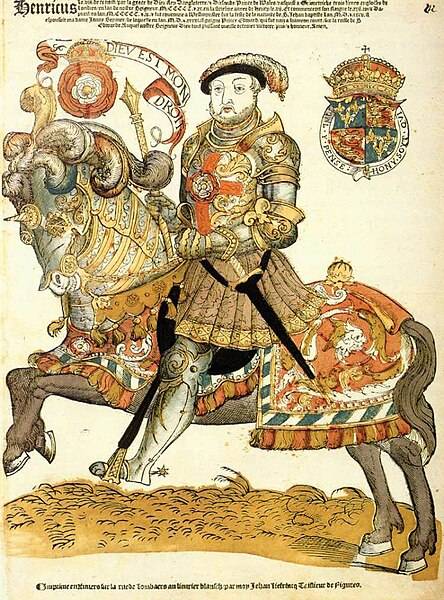
King Henry VIII of England was a great lover of all kinds of shooting curiosities. Hans Liefrink (1538–1599). "King of England Henry VIII on horseback". The Rijksmuseum is an art museum in Amsterdam, the Netherlands.
The transportation of such cannonballs, as well as such massive guns from which they were fired, was the main concern of the generals of the 1470th and 24th centuries. A Burgundian source from the XNUMXs reports that it took XNUMX horses to transport a large bombard, eight horses for a crappod, four horses for a medium serpentine, and two horses even for a small serpentine.
In 1388, to transport one German bombard belonging to the city of Nuremberg, it took 12 horses to drive the barrel, another 20 horses to transport accessories and carriage parts, and another 20 horses to transport ammunition. Moreover, only three stone balls weighing 560 pounds each were placed on one wagon. A horse was also needed for the chief gunner and a wagon for his six assistants and their tools.
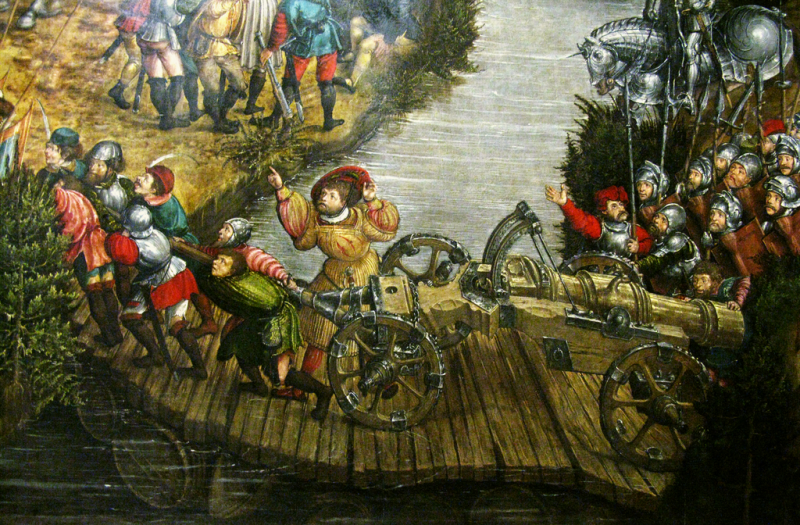
Transportation of heavy weapons at the beginning of the 1490th century. Detail from a painting by Hans Krell (1565–8). "The Battle of Orsha on September 1514, 1525". Painted around 1530–XNUMX National Museum, Warsaw
The weight of the cannons was so great that roads and especially bridges often required reinforcements to support them. In 1453, for example, Philip the Good of Burgundy had to deliver a 17-foot bombard weighing 7 pounds from Mons to Lille, which required additional strengthening of each bridge along its path with iron supports. When at some point this monster went into a ditch, it took two whole days to get it back on the road. This is why cannons and ammunition at that time were often transported by river, as was done by the English in Normandy and Gascony in the 764s and the Burgundians in Flanders in 1420.
Finally, it should be noted that the older types of artillery, trebuchet and ballista, continued to be used along with guns until the 1370th century. For example, the French who besieged Rennes in 1453 used trebuchets. The Byzantines also used trebuchets during the last siege of Constantinople in 1480, while the Ottomans used slings against Rhodes until XNUMX.
PS
I have been asked more than once how the finds of medieval metal products are researched, and whether they are researched at all, because, they say, historians "are not friends with modern exact sciences." Well, especially for those who would like to get acquainted with how they take metal analyzes from a found artillery barrel and examine the structure of its surface under a microscope, I found this material.
When I started reading it myself, it just hit my head from the abundance of formulas and all kinds of figures in which I did not understand a word. But, perhaps, among the readers of VO there is an enthusiast who will master all this? So to speak, will he master the “real science”, and then introduce it to all of us? Here is the material: "A late medieval or early modern light gun barrel from the Castle Museum in Malbork - typology, technology of manufacture and identification of the smelting process". Authors: Grzegorz Żabiński, Mateusz Biborski & Ewelina A. Miśta-Jakubowska. Archaeological and Anthropological Sciences.
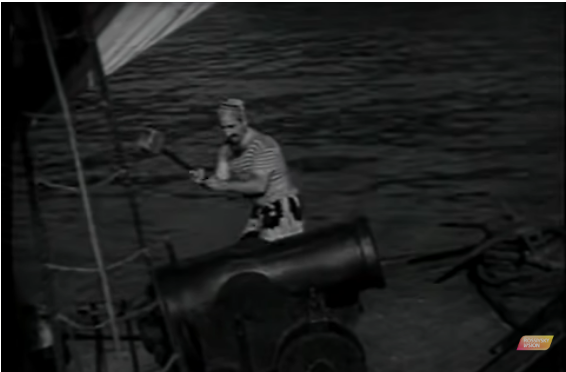
Pss Surprisingly, my interest in artillery woke up very early, somewhere before 1962, when I watched the 1938 movie “Doctor Aibolit”, where the pirates had, well, just a wonderful cannon, which, before firing, also had to be lubricated, otherwise she didn't shoot!
Information